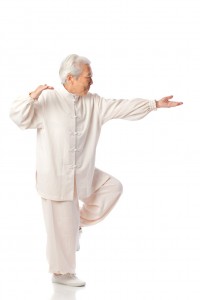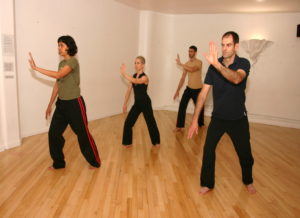
In Yang Tai Chi we have several old writings called the Classics. The Classics, compiled from the papers of famous Tai Chi practitioners, included among the classics is a treatise by Yang Cheng-Fu, grandson of the founder of Yang Tai Chi Chuan.
Here are the 10 essential points when doing Tai Chi. Without them, your Tai Chi is not considered real Tai Chi.
1) Uplift energy to the top with an empty feeling
Raise your head naturally, without making your neck and body stiff. When your head is carried erect and relaxed, your spirit (shen), intentions (yi), and internal energy (chi) are directed through your eyes.
2) Hold the chest in an arch the back
Relax your chest muscles, allowing your breathing level to drop closer to your lower abdomen. That gives you more relaxed, natural lung capacity. When you relax your chest muscles, you naturally round your back slightly, helping keep your upper and lower back straight.
3) Relax waist and loosen crotch between two legs
Relax the waist, giving yourself more flexibility in this region. Loosen the crotch area by opening the hips. The waist and hip action direct the power produced in the legs.
4) Distinguish between empty and full
If the body’s center of gravity, which carries most of the body’s weight, rests over the right leg, that leg is full. Since the left leg has less weight and no center of gravity over it, it is empty. In tai chi chuan, the center of gravity should be in a straight line over the supporting leg. It is spread evenly between both legs; you are double weighted, which is incorrect. The double-weighted person is easily pulled off balance and can’t move quickly and easily in any direction.
5) Sink the shoulders and drop the elbows
Relax your shoulders. Your elbows should point down. If the joints are tense or the elbows stick out, your breathing and chi levels rise, making your breathing shallow and entire body tense. Also, if you raise your shoulders and elbows, your body will be stiff, making it easy to be pulled or pushed off balance.
6) Use intention, not strength
Use your mind (yi) to accomplish your action, not tense brute force. That keeps your body relaxed and supple, yielding, and redirecting rather than exerting force against force.
7) Top and bottom follow each other
The root of your movements starts with the foot position. The legs then produce energy or power. The waist and hips direct the power, and the arms and hands then release this power. Each part of this sequence must be connected and done in the correct order.
8) Internal and external are in mutual harmony
Internal energy (chi) and external power (muscle strength) are both necessary. However, you should not have an excess of one over the other. Both should balance each other.
9) Connect without breaking
Each movement in the form should be a continuous expression of the tempo and speed from the previous move. Even though the body momentarily stops between posture to change to a new position, your intention continuously unbroken. There should be no hard, fast movements followed by soft, slow actions or vice versa.
10) Attain motion in silence
Although you are moving, your mind should be calm and quiet. That allows you to breathe easily, think clearly, and move with agility.
These are Yang Cheng-Fu’s ten principles of correct tai chi practice. No matter which form you use, if you follow these principles, you will benefit from the health advantage tai chi has to offer.